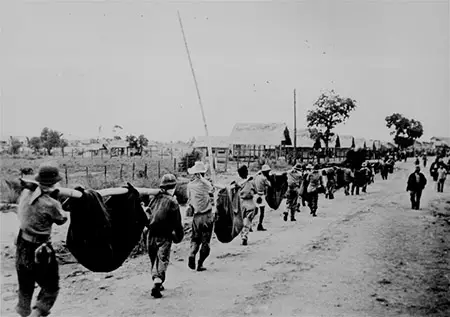Bataan Death March
Background
In December 1941, Japan invaded the Philippines, an island in South-East Asia, defeating Filipino and American soldiers. The battle of Bataan was fought between January and April 1942. On April 9, U.S. General Edward King, Jr. surrendered his army of around 78,000 troops.


Planning the March
The Japanese General, Masaharu Homma, decided to transfer the troops to a prisoner of war camp. On the 10th of April, 1942 the men were rounded up, searched and had their belongings taken away from them.
The plan involved gathering all the men together in Mariveles in the south, close to the original battle site. Then they were to be transported, in groups of 500 to 1000, to a permanent prisoner of war camp. There was no adequate means of transport in the area, so marching them on foot was the only real option.
From Mariveles they were to march more than 60 miles north to a village called San Fernando. From here the prisoners would travel by train for 25 miles to the town of Capas and then march on foot once more for about 7 miles to Camp O’Donnell, which had been a Philippine army post.

What was the March like?
According to their ancient warrior traditions, the Japanese saw surrender as shameful. They believed that a soldier should die before giving in and this was one of the reasons for the horrible treatment of the American prisoners.
The March lasted for a week, although it went on for up to 12 days for others. The prisoners had to march in extremely hot conditions as they made their way through the jungle. Many became really ill with dysentery, malaria and other tropical diseases.
The soldiers were given almost no water or food, making the journey even harder. At best the prisoners were given a few cups of rice, and little or no water. Some local Filipinos saw the men suffering and attempted to give them food and water, but this kindness was dangerous as some of these helpers were beaten or killed by Japanese troops.
Due to extreme thirst some men took risks, such trying to drink dirty water from the side of the road. Those who were caught doing these things, did not keep up, or fell behind due to illness and exhaustion, were murdered by Japanese troops. They were killed by bayonets, which were swords, or spike-shaped weapons fixed onto rifles, and many were shot.
Part of the journey took place on trains, but the conditions were not much better here. Large numbers of prisoners were forced into very hot and stuffy boxcars and remained there for hours on end unable to move, or even go to the toilet. Many suffocated in these bad conditions.

What Happened to the prisoners?
Many men died as a result of the March. Some of the troops managed to escape, although many of them were caught and killed. Of the 11,796 Americans who were at Bataan after their defeat, 650 died on the Death March. Between 5,000 and 10,000 Filipino soldiers lost their lives. Many more died when they reached the camp.

Aftermath
America had promised to return to the Philippines at the time of its defeat. In February 1945, the American and Filipino troops united once more to recapture the Bataan Peninsula. Manila, the capital city of the Philippines, was liberated in early March.
General Homma surrendered to the Americans in Tokyo in December 1945, after the Japanese had been defeated by the USA. He was put on trial for not respecting international rules of war and allowing his men to commit war crimes against the U.S. and Filipino troops. He was executed by firing squad on the 3rd of April 1946.



